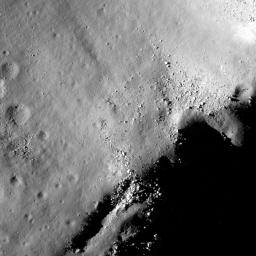
|
Uplift, Boulders of Tsiolkovskiy
- Click the image above for a larger view
- Full-Res JPEG (1600 x 1600) (333.7 kB)
- Full-Res TIFF (1600 x 1600) (2.6 MB)
Caption:
Boulders perched on the summit of the central peak of Tsiolkovskiy crater. Tsiolkovskiy (185 km diameter) is a spectacular example of complex impact crater. It has a terraced rim, a central peak, and a floor flooded with mare basalts. Impact events release tremendous amounts of energy and result in very dynamic changes in the local landscape. Just after the initial impact, the central peak was uplifted from lower crustal rock, forming a giant mountain in the middle of the crater. Later large and small pieces of that uplifted rock rolled down and accumulated at the base of the slope -- just waiting for future lunar explorers to examine. This strategy was used by the Apollo 17 astronauts as an easy way to sample nearby mountain tops without having to climb to the top. Frequently it is easy to see where a boulder came from by following its tracks, a great clue to geologists reconstructing the local geology. The largest boulder in this image is about 40 meters wide - half as big as a soccer field! The dark area in the lower right is the tip of enormous shadow cast by the central peak. Scroll north in the full image, and you will find the contact where the later-formed lavas pooled at the base of the peak. Even though the central peak formed before the mare, it has fewer craters due to its steep slope which tends to slump and slide erasing small craters. In this case, that's an apparent violation of the rule that older surfaces have more craters!
Background Info:
NASA's Goddard Space Flight Center built and manages the mission for the Exploration Systems Mission Directorate at NASA Headquarters in Washington. The Lunar Reconnaissance Orbiter Camera was designed to acquire data for landing site certification and to conduct polar illumination studies and global mapping. Operated by Arizona State University, the LROC facility is part of the School of Earth and Space Exploration (SESE). LROC consists of a pair of narrow-angle cameras (NAC) and a single wide-angle camera (WAC). The mission is expected to return over 70 terabytes of image data.
Cataloging Keywords:
| Name | Value | Additional Values |
|---|---|---|
| Target | Moon | |
| System | Earth | |
| Target Type | Satellite | |
| Mission | Lunar Reconnaissance Orbiter (LRO) | |
| Instrument Host | Lunar Reconnaissance Orbiter | |
| Host Type | Orbiter | |
| Instrument | Lunar Reconnaissance Orbiter Camera (NAC) | |
| Detector | Narrow Angle Camera (NAC), Wide Angle Camera (WAC) | |
| Extra Keywords | Crater, Grayscale, Impact, Mountain, Shadow | |
| Acquisition Date | ||
| Release Date | 2009-09-01 | |
| Date in Caption | ||
| Image Credit | NASA/GSFC/Arizona State University | |
| Source | photojournal.jpl.nasa.gov/catalog/PIA12902 | |
| Identifier | PIA12902 | |
